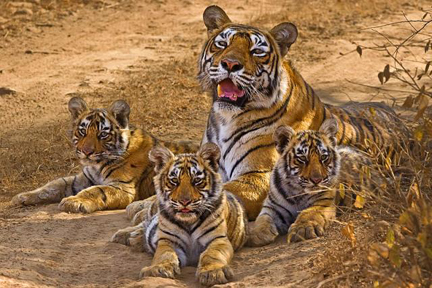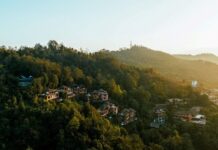 Wildlife safaris, medieval palaces & even shopping
Wildlife safaris, medieval palaces & even shopping
Sariska Tiger Reserve is well nestled in the Aravali Hills covering 800 sq km area divided into the grasslands, dry deciduous forests, sheer cliffs and rocky landscape. Whether you want to have camel safaris, go out for shopping in the surrounding places, visit medieval palaces or wildlife watching; Sariska Wildlife Sanctuary is the best place for you.
Nearly 90% of the area in the sanctuary is covered with dhok trees accommodating various wildlife species. A variety of other wild animals like the leopard, sambhar, chital, nilgai, four-horned antelope, wild boar, rhesus macaque, langur, hyena and jungle cats are found in the Sariska Tiger Reserve apart from the tiger. The Sariska National Park is home to India’s largest population of peafowl, and harbors quail, sand grouse, golden- backed woodpeckers and crested serpent eagles, among other species. Also the Siliserh Lake on the edge of the park has a large number of crocodiles.
The sanctuary houses the ruins of medieval temples of Garh-Rajor that date back to the 10th and 11th centuries. Also a 17th century castle on a hilltop at Kankwari provides a panoramic view of flying vultures and eagles. The Sariska was declared a sanctuary in 1955 and attained the status of a National Park in 1979.
Wildlife in Sariska Tiger Reserve
The Sariska Tiger Reserve is home to a number of carnivores including Leopard, Wild Dog, Jungle Cat, Hyena, Jackal, and Tiger. The herbivore category in Sariska includes Sambhar, Chitel, Nilgai, Chausingha, Wild Boar and Langur. Sariska wildlife sanctuary is also known for its large population of Rhesus Monkeys.
There are also many bird species in Sariska Tiger Reserve, namely; Peafowl, Grey Partridge, Bush Quail, Sand Grouse, Tree Pie, Golden Backed Wood Pecker, Crested Serpent Eagle and the Great Indian Horned Owl.
Special Attractions
The Kankwari Fort: The major historic structure within the Sariska National Park includes the Kankwari Fort where Emperor Aurangzeb once imprisoned his brother, Dara Shikoh.
The Ancient Shiva Temples: The Neelkanth Temples within the Sariska Tiger Sanctuary date back to the 6th -13th century AD, though in dilapidated condition, is a must visit.
The Sariska Palace: The Maharajas of Alwar built the Sariska Palace standing amidst the Sariska Wildlife Sanctuary. The Palace has now been converted into a hotel.
Jeep Safari: The best way to explore the Sariska Wildlife Sanctuary is by jeep which can be arranged at the Forest Reception Office on Jaipur Road. You can even book a `hide’ overlooking one of the water holes, and also provides an excellent opportunity for wildlife viewing and wildlife photography within the Sariska Wildlife Sanctuary.
When to Visit
As such, the Sariska Tiger Reserve can be visited throughout the year; still the best time to have Sariska tour is from October – June and January – February. Certain jungle tracks are closed during the monsoon and the breeding season just to safeguard the animals and the reserve. If you can tolerate heat, April to June is ideal to catch-hold of the animals at the waterholes.
Best Time to Visit: The best time to visit this beautiful countryside is between November and June. One can see the most of the animals in the evening.
How to Reach
By Air: The nearest airport from Sariska National Park is at Jaipur.
By Rail: The nearest railhead is at Alwar at a distance of 37-kms.
By Road: Sariska Wildlife Sanctuary is situated on the Delhi-Jaipur highway near Jaipur and Delhi. Sariska is also well connected with Alwar.
.




